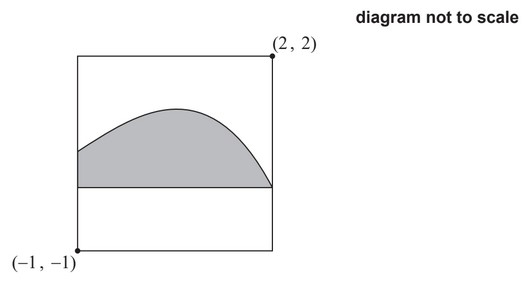Question
A modern art painting is contained in a square frame. The painting has a shaded region
bounded by a smooth curve and a horizontal line.
When the painting is placed on a coordinate axes such that the bottom left corner of the
painting has coordinates (−1, −1) and the top right corner has coordinates (2 , 2), the
curve can be modelled by y = f (x) and the horizontal line can be modelled by the x-axis.
Distances are measured in metres.
(a) Use the trapezoidal rule, with the values given in the following table, to approximate
the area of the shaded region.
| x | -1 | 0 | 1 | 2 |
| y | 0.6 | 1.2 | 1.2 | 0 |
The artist used the equation \(y=\frac{-x^3-3x^2+4x+12}{10}\) to draw the curve.
(b) Find the exact area of the shaded region in the painting.
(c) Find the area of the unshaded region in the painting.
Answer/Explanation
Ans:
(a) \(\frac{1}{2}(0.6+0+2(1.2 + 1.2))\)
2.7 \(m^2\)
(b) \(\int_{-1}^{2}\frac{-x^3-3x^2+4x+12}{10}\) OR \(\int_{-1}^{2}f(x)dx\)
2.925 \(m^2\)
(c) 9-2.925
= 6.08 \(m^2\) (6.075)
Question
Find \(\int {\frac{1}{{2x + 3}}} {\rm{d}}x\) .
Given that \(\int_0^3 {\frac{1}{{2x + 3}}} {\rm{d}}x = \ln \sqrt P \) , find the value of P.
Answer/Explanation
Markscheme
\(\int {\frac{1}{{2x + 3}}} {\rm{d}}x = \frac{1}{2}\ln (2x + 3) + C\) (accept \(\frac{1}{2}\ln |(2x + 3)| + C\) ) A1A1 N2
[2 marks]
\(\int_0^3 {\frac{1}{{2x + 3}}} {\rm{d}}x = \left[ {\frac{1}{2}\ln (2x + 3)} \right]_0^3\)
evidence of substitution of limits (M1)
e.g.\(\frac{1}{2}\ln 9 – \frac{1}{2}\ln 3\)
evidence of correctly using \(\ln a – \ln b = \ln \frac{a}{b}\) (seen anywhere) (A1)
e.g. \(\frac{1}{2}\ln 3\)
evidence of correctly using \(a\ln b = \ln {b^a}\) (seen anywhere) (A1)
e.g. \(\ln \sqrt {\frac{9}{3}} \)
\(P = 3\) (accept \(\ln \sqrt 3 \) ) A1 N2
[4 marks]
Question
A function f (x) has derivative f ′(x) = 3x2 + 18x. The graph of f has an x-intercept at x = −1.
Find f (x).
The graph of f has a point of inflexion at x = p. Find p.
Find the values of x for which the graph of f is concave-down.
Answer/Explanation
Markscheme
evidence of integration (M1)
eg \(\int {f’\left( x \right)} \)
correct integration (accept absence of C) (A1)(A1)
eg \({x^3} + \frac{{18}}{2}{x^2} + C,\,\,{x^3} + 9{x^2}\)
attempt to substitute x = −1 into their f = 0 (must have C) M1
eg \({\left( { – 1} \right)^3} + 9{\left( { – 1} \right)^2} + C = 0,\,\, – 1 + 9 + C = 0\)
Note: Award M0 if they substitute into original or differentiated function.
correct working (A1)
eg \(8 + C = 0,\,\,\,C = – 8\)
\(f\left( x \right) = {x^3} + 9{x^2} – 8\) A1 N5
[6 marks]
METHOD 1 (using 2nd derivative)
recognizing that f” = 0 (seen anywhere) M1
correct expression for f” (A1)
eg 6x + 18, 6p + 18
correct working (A1)
6p + 18 = 0
p = −3 A1 N3
METHOD 1 (using 1st derivative)
recognizing the vertex of f′ is needed (M2)
eg \( – \frac{b}{{2a}}\) (must be clear this is for f′)
correct substitution (A1)
eg \(\frac{{ – 18}}{{2 \times 3}}\)
p = −3 A1 N3
[4 marks]
valid attempt to use f” (x) to determine concavity (M1)
eg f” (x) < 0, f” (−2), f” (−4), 6x + 18 ≤ 0
correct working (A1)
eg 6x + 18 < 0, f” (−2) = 6, f” (−4) = −6
f concave down for x < −3 (do not accept x ≤ −3) A1 N2
[3 marks]
Question
Let \(f\left( x \right) = 6{x^2} – 3x\). The graph of \(f\) is shown in the following diagram.
Find \(\int {\left( {6{x^2} – 3x} \right){\text{d}}x} \).
Find the area of the region enclosed by the graph of \(f\), the x-axis and the lines x = 1 and x = 2 .
Answer/Explanation
Markscheme
\(2{x^3} – \frac{{3{x^2}}}{2} + c\,\,\,\left( {{\text{accept}}\,\,\frac{{6{x^3}}}{3} – \frac{{3{x^2}}}{2} + c} \right)\) A1A1 N2
Notes: Award A1A0 for both correct terms if +c is omitted.
Award A1A0 for one correct term eg \(2{x^3} + c\).
Award A1A0 if both terms are correct, but candidate attempts further working to solve for c.
[2 marks]
substitution of limits or function (A1)
eg \(\int_1^2 {f\left( x \right)} \,{\text{d}}x,\,\,\left[ {2{x^3} – \frac{{3{x^2}}}{2}} \right]_1^2\)
substituting limits into their integrated function and subtracting (M1)
eg \(\frac{{6 \times {2^3}}}{3} – \frac{{3 \times {2^2}}}{2} – \left( {\frac{{6 \times {1^3}}}{3} + \frac{{3 \times {1^2}}}{2}} \right)\)
Note: Award M0 if substituted into original function.
correct working (A1)
eg \(\frac{{6 \times 8}}{3} – \frac{{3 \times 4}}{2} – \frac{{6 \times 1}}{3} + \frac{{3 \times 1}}{2},\,\,\left( {16 – 6} \right) – \left( {2 – \frac{3}{2}} \right)\)
\(\frac{{19}}{2}\) A1 N3
[4 marks]
